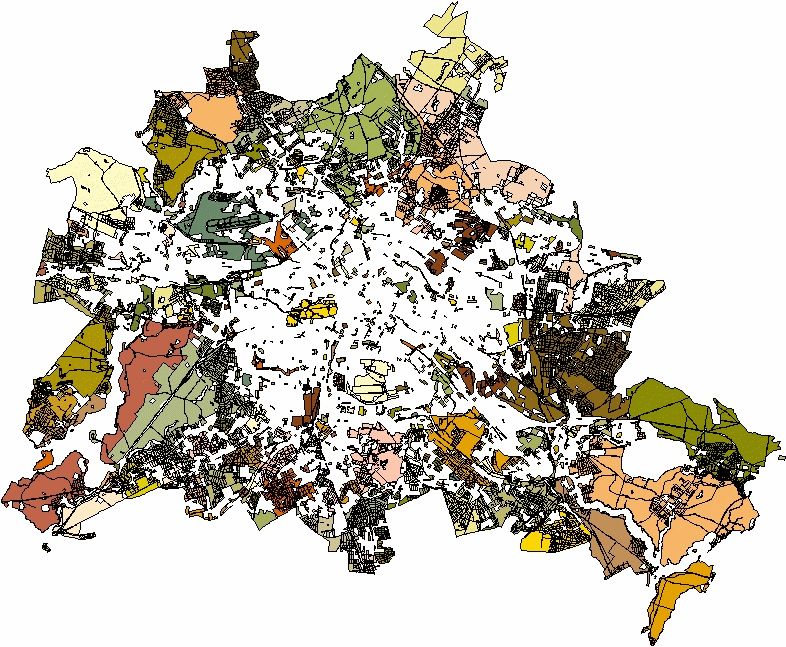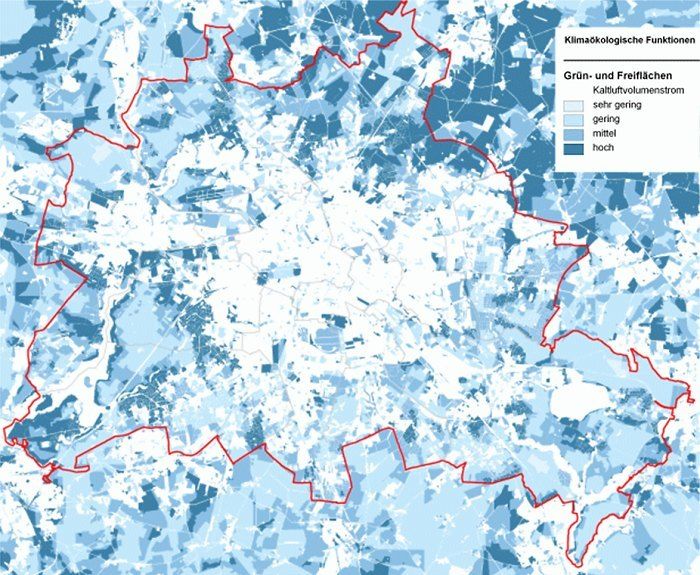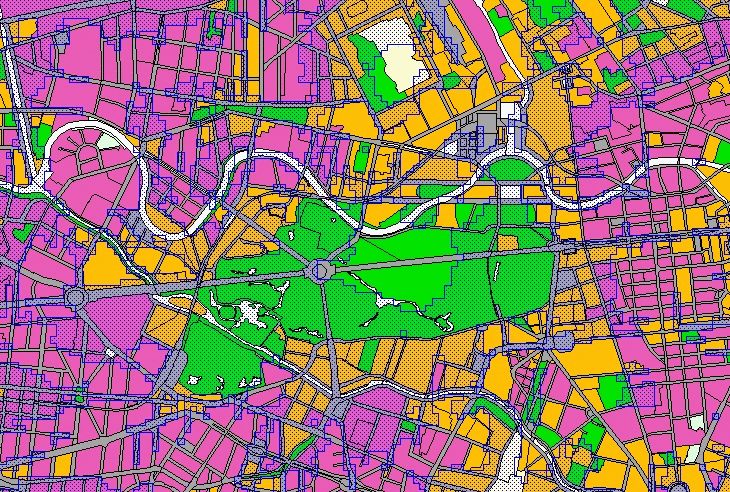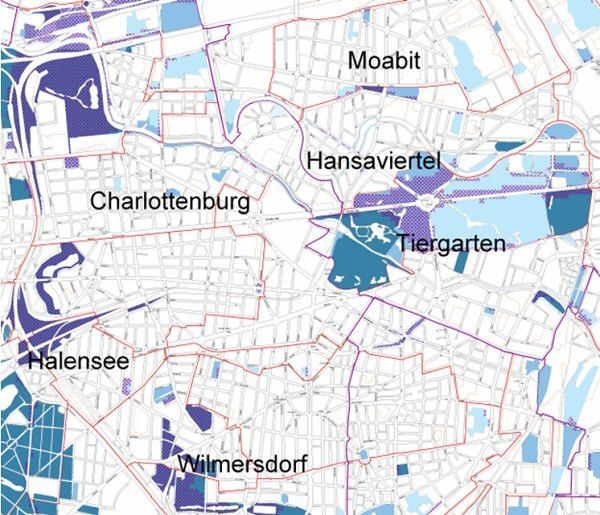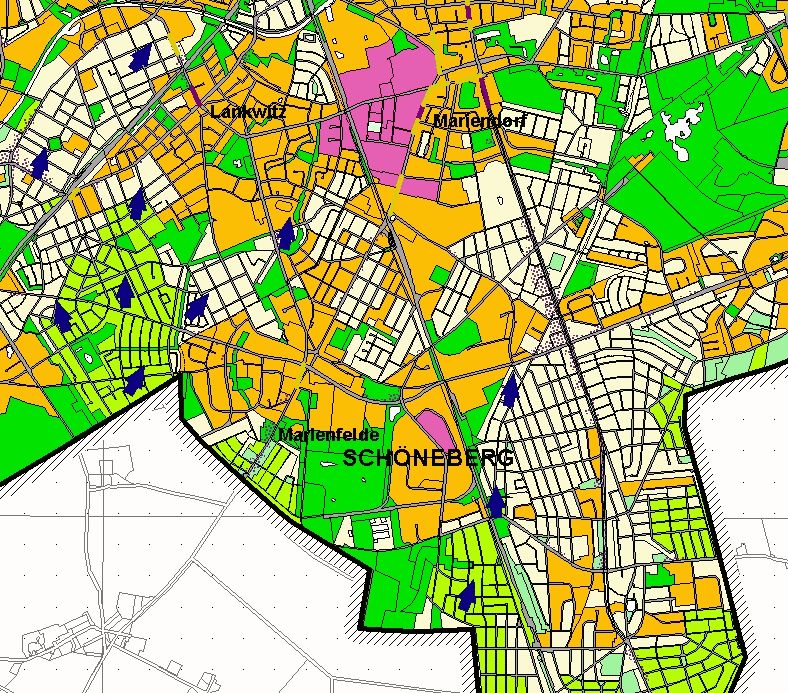Air exchange
Structures which allow air exchange and introduce cold air are the central link between compensation spaces and bio-climatically burdened affected spaces. Air-stream channels should usually offer a low surface roughness, whereby lesser wooded valley and floodplain areas, larger green spaces and tracks offer the required attributes. Wide roads, because of their immission load, can only aid the climatic balance, but not the transport of fresh air. The air-stream channels are sub-divided according to process in the Climate Functions Map, where a cold air producing (partial) area can also fulfil a function as a ventilation lane.
The predominant form of ventilation lanes are thermally induced types in combination with a compensation space, which can be led back to the utilisation-based temperature differences. Exemplary for such inner city channels are the allotments at the Priesterweg which transport the cold air northwards coming from the graveyard on Bergstraße in Steglitz and from Insulaner. Furthermore the allotment am Heckerdamm as well as the Volkspark Rehberge channel a fraction of the cold air produced at the Airport Tegel towards the city centre. A number of further thermally induced ventilation lanes can be found north of the axis Tegel – Lichtenberg as well as in the south between Lichterfelde and Bohnsdorf. In the western part of the city the lanes are grouped around Spandau and lead cold air directly out of the northern Grunewald and the bordering regions towards the city. If a green space borders directly on a developed area, a ventilation lane becomes obsolete.
Predominantly orographically induced ventilation lanes are concentrated in the eastern part of the city. These are about valleys, e.g. Wuhle and Mühlenfließ, which, because of their alignment, width and terrain attributes, can be used as air-stream channels. To that effect, one can class in the western part of the city the depth line from Grunewald trough Hundekehlsee – Dianasee – Koenigssee – Halensee.
The lowlands of the larger rivers like Spree and Havel exceed this function and also possess a characteristic for superordinated air-stream and ventilation channels. They benefit the air exchange in the bordering developed areas even under strong, dominating weather conditions.
A spatial cold air out-flow is limited to areas with an inclination of > 1°, and is, because of the relatively low height differences, scarce in Berlin.
For that reason this process is interlinked to the few areas with a noteworthy inclination like that of the Grunewald and the Köpenicker Bürgerheide. Furthermore, in the northern part of the Tegeler See, Kaulsdorf and in the Forst Düppel one can assume cold air flow. The cold air generation is above average on these wooded slopes because the long-wave emission is very high, and with that the primary cooling rate. This occurs not from the ground, but from the upper treetops. Due to the size of the emanating surface the cold air can flow in and over the treetops, instead of first subsiding into the trunk area (Groß 1989).
Map 04.11.2 Planning Advices Urban Climate
The Planning Advices Urban Climate Map is an integrated evaluation of the facts relevant to planning shown in the Climate Functions Map. Protection and development measures for the improvement of the climate and also – by means of attenuation and removal effects – of the air. The goals of
- Protection,
- Development and
- Reconstruction of
climatic and immissions-ecologically important surface structures (Mosimann et al. 1999) correspond to the main idea of these efforts. The associated planning advices provide information on the sensitivity against usage changes from which climate-founded requirements and measures in the course of areal planning can be deduced. With regard to the adaptions to the climate change, these findings shall furthermore help to make the necessary planning regulations.
Below, the planning classification of climate-relevant elements in Berlin is considered. Detailed, block-related planning recommendations can be found in the digital version of the planning advices map.
Green- and open space inventory
Urban green spaces and green spaces near settlements have a substantial effect on the urban climate and positively influence the direct surroundings micro-climatically. Larger coherent green spaces constitute the climatic regeneration potential. The produced cold air mass flow as a qualifying parameter, however, takes a back seat in this regard. The spatial position and with it the question which bioclimatic load a respective building development involves, is much more important for a classification in the planning process. Ultimately, a green space with only minor production of cold air can also bring with it a significant benefit in densely settled areas.
Of very high importance concerning the urban climate are green and open spaces with an impact on bio-climatically stressed settled areas. These are above all large, inner-city green spaces such as Großer Tiergarten and Volkspark Friedrichshain, and open spaces on the premises of the Airport Tempelhof. Vitally important are furthermore smaller parks, ruderal areas and wasteland, as well as sports grounds that are only sealed up to a moderate extent, as far as they can achieve a relieving effect on the neighbourhood. This results in the highest sensitivity of these areas against intensification of utilisation and the following planning advices:
- Avoidance of exchange barriers against built-up border areas,
- Reduction of emissions and
- Cross-linking with open spaces.
This means that edificial works and utilisation contributing to the sealing of these areas can lead to further alarming climatic damage. Alongside the aforementioned and other individual areas of this class the larger distant areas such as open spaces adjoining Blankenfelde or in the Wuhlheide can also be assigned to this category.
Green and open spaces with a connection to urban areas with a low level of pollution or even a favourable microclimate possess a high to medium importance to the urban climate. They are mostly located in a considerable distance from the city centre and are connected to the urban areas with a minor bio-climatic load that is situated beyond the course of the outer urban railway line (S-Bahn-Ring). Among these are the following areas:
- Green spaces and suburbs pervaded by greenery between Bucher Forest and Malchow,
- Krummendammer- and Köpenicker Bürgerheide,
- Forest Grunewald northwest of the Avus as well as Jungfernheide and
- Forest Spandau.
These areas possess a high sensitivity regarding utilisation intensification, whereby air exchange with its surroundings should be especially considered.
The third category constitutes green and open spaces of low urban climatic importance. These are areas which either possess a minor influence on – burdened – developed settlements, or have an insignificant cold air production. The latter can often only offer a small area size and are usually situated in the inner city. These areas can by all means take on a role as climatically ecological comfort islands, provided that they feature micro-climatic diversity (e.g. bodies of water, shadowed and sunny areas).
The green-shaped development relevant for urban climate represent larger areas with a low sensitivity (cf. climatically favourable settlement areas). As far as they do not border directly on loaded areas, a further development, which does not affect local air exchange considerably, would only result in minor changes in urban climate.
Settlement areas
Climatically favourable settlement areas are sparsely developed and green settlements, e.g. mansions with a low sealing level, a high vegetation level and a relatively high nocturnal cooling rate. These areas are cold air producers themselves, to a certain extent, and aid the cold air flow of neighbouring open spaces. Green settlements are usually found outside of the S-Bahn-Ring, but some are near the city centre (e.g. Garden City Tempelhof west of the Airport). These areas lead neither to an intensive bio-climatic impact, nor do they impede air exchange. Thus they mostly show a low PMV-value (cf. settlement areas in chapter methodology), which is the basis for the evaluation of the bioclimatic situation into four classes (most favourable / favourable / less favourable / unfavourable) according to VDI-guideline 3785.
The bioclimatically most favourable development usually has a medium sensitivity against utilisation intensification, as long as the building heights are kept low and the parts of the structures are aligned to the cold air flow. Spaces bordering directly on burdened areas will have a high sensitivity due to the climatic relevance.
The bioclimatically favourable development is also among the minor loaded settlement area, but do not constantly show a cold air ventilation. If these areas border on stress areas, this will result in a high sensititvity in respect of use intensification and the avoidance of further densification. If there is no immediate vicinity to loaded areas, there is only a low sensitivity to structural alteration.
Stress areas, on the other hand, usually exhibit ventilation deficiencies and an above-average heat load. These are divided into settlement areas with the categories less favourable as well as unfavourable. Under consideration of the stress level, a high or very high sensitivity regarding utilisation intensification results. Under urban climatic aspects, these areas are in need of rehabilitation, which results in the following planning advice:
- No further aggregation,
- Improvement of ventilation and increase of vegetation,
- Conservation of all open spaces and
- De-sealing and, if necessary, planting of inner courtyards.
Beside the inner city area there are also districts with strongly developed centres, e.g. Spandau, Weißensee or Hohenschönhausen. Furthermore, a low to average local impact may occur in the entire city area and is not limited to the aggregation areas. In isolated cases a bio-climatic impact can occur despite an existing cold air affect range. In such a case the potential impact situation can be so high that even a cold air flow is not able to achieve a significant compensation.
The situation in the peripheral area of Tempelhof is shown in Fig 8. The bio-climatically impacted industrial areas along the S-Bahn tracks are especially visible, in particular in the district of Mariendorf. At the same time, the green-shaped development becomes noticeable as climatically favourable settlement areas (lime green and beige colour).

